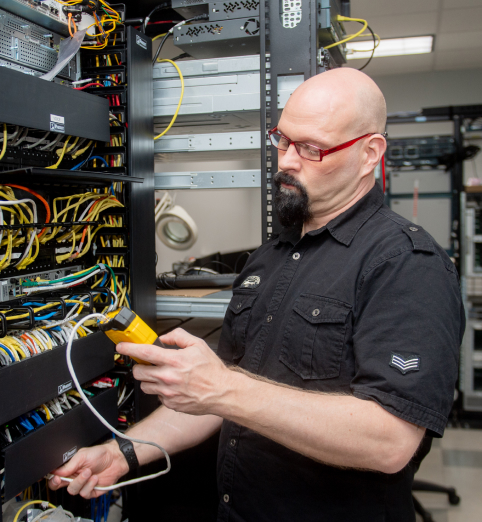In 2019 alone, the world disposed of around 300 million tons of plastic. (How do you even wrap your mind around that?) Then, floating around somewhere near that sea of plastic in 2019 was 53.6 million tons of e-waste, according to the UN. And in the US, only 15% of it was recycled.
This all sounds bad enough, until this last stat kicks in. The 85% of e-waste left behind after recycling represents 70% of the overall toxic waste in the United States. Once we understand the devices our employees use and the tech equipment supporting our businesses are such a big contributor to destabilizing our environment, it goes a long way to convincing us something has to change.
When technology creates this big of a threat to sustainability, technology clearly has a responsibility to be part of the solution. And let’s be real: change doesn’t happen until money talks.
This is exactly why ITAD (IT Asset Disposition) specialists have shifted their focus from just getting rid of your old stuff to the environmental and financial value of a Circular Economy.
What Is a Circular Economy and How Does It Support Sustainability?
OK, we realize we dropped a term there which might be new to you and might sound like the next big buzz-word. We promise; it’s not just trendy. It’s a real, viable solution.
At its simplest, a Circular Economy is an industrial system like an ecosystem or the human body because it is designed to be regenerative. Instead of throwing everything unusable out, it asks the simple but powerful question, “What can be reused or renewed?”
In ITAD, the Circular Economy is a sustainable, cost-effective approach focused on:
- The reuse and recycling of resources and equipment.
- A more conscious management of existing resources. (Here’s where the rubber starts to hit the road, where real value is found instead of just focusing on managing waste.)
One of the key principles of a circular economy is to eliminate or “design out” waste. In this model, products are meant to be used and then reused, eliminating waste while also saving both the energy and labor needed to recycle these materials.
While it’s crucial for businesses to be empowered to recycle unusable gear, it’s even more important to learn how to reuse existing assets. A Circular Economy is a double-win where your business stands to save money on tech infrastructure while preventing environmental damage to our planet.
Why Sustainability Matters In ITAD
ITAD professionals know the toll trashed gear takes on the environment. We feel the weight of responsibility with every server we pull out of a rack. This is why sustainability and a thorough understanding of the impact of improper IT asset disposal are front and center in our minds.
ITAD is way more than the picking up and disposing of your unwanted stuff. It’s a start-to-finish process to get the most value out of obsolete equipment while limiting the negative environmental fallout.
We love being able to deliver the double-win for clients. ITAD should always be about gaining as much value as possible from your gear. Making that happen while reducing environmental impact is a rewarding experience for everyone, in every way.
Finding the right ITAD provider who shares your values and concerns over sustainability is key, and we have a resource available to help you better understand the industry and your options.
Sustainability in ITAD Requires Creative Solutions
The go-to, Circular-Economy solution, of course, is to try and keep a tech asset in use for your business.
When this solution isn’t viable, many businesses don’t realize that even though the gear is now outdated for their purposes, there are loads of other organizations who don’t have the same level of requirements.
- Sometimes this leads to the ability to resell an asset.
- Other times, it helps the community. For example, how many schools or organizations would benefit from a used computer?
This is exactly why IT asset disposition and the circular economy are so closely tied! There’s more than one way to “dispose” of unwanted gear, and you want to partner with someone who is able to think outside the box.
The Benefits of Supporting a Sustainable, Circular Economy Through ITAD
So, we all get it. We’re all on board. Who doesn’t want to save the planet (other than a deranged James Bond villain)?
Still, economics drive change. Too many opportunities to protect the environment are lost because of the lack of a sound, financial rationale.
For example, when you study the history of America’s National Parks, you meet one of the champions of preserving those lands, John Muir. He kicked off the movement by appealing to the spirit, to the morality of protecting our nation’s beauty for all citizens to experience.
However, appealing to the spirit only went so far. It was John Muir’s disciples and followers who figured out the real formula for keeping the beauty of places like Yosemite safe from development. They proved how much money could be made from tourism. They showed the local communities how much more profit could be gained by protecting the land than exhausting its resources.
You’ve got people you must answer to, people who will fear change and assume the “mission” of sustainability will hurt the bottom line. Here’s what you tell them.
There are many benefits to the Circular Economy concept.
- Cost Savings – Your business stands to save money on both the disposal of old equipment and the purchase of new gear.
- Financial Opportunities Born from Innovative Solutions – When the ability to save and/or generate revenue meets a mission-based concept like the Circular Economy, real progress begins. In the immediate future, ITAD professionals will compete to find new ways to extend the life of assets, which only benefits your company. On the far edge of the horizon—compostable infrastructure; in 2012 the Open Compute Project challenged students at Purdue University to create biodegradable server chassis, and the idea of creating them out of substances like cardboard is still being pursued.
- Job Creation and Economic Growth – A 2019 article in Fast Company predicted a jobs boom from the adoption of the Circular Economy concept and cited a United Nations study projecting $2 Trillion in growth in the world economy by 2050 from using resources more effectively.
Contributing to Sustainability Through Tech is a Win for Your Business
Those examples above are only the beginning in terms of earning potential and growth. This is simply a moment where the right thing to do meets the right thing for your bottom line, and how often do those come along?
- You don’t have to sacrifice your profit margins to support a circular economy.
- You don’t have to lose any ground in your technological capabilities.
You simply stand to save money which would have been spent on new equipment and recycling and disposal costs. You stand to gain far more value from your capital investments in technology.
Inteleca spends every day thinking about the full lifecycle management of IT assets, especially extending or finding new life for the older ones. Contact us here, and one of our engineers will reach out to schedule a call to help strategize your first steps into the Circular Economy and its many benefits.



